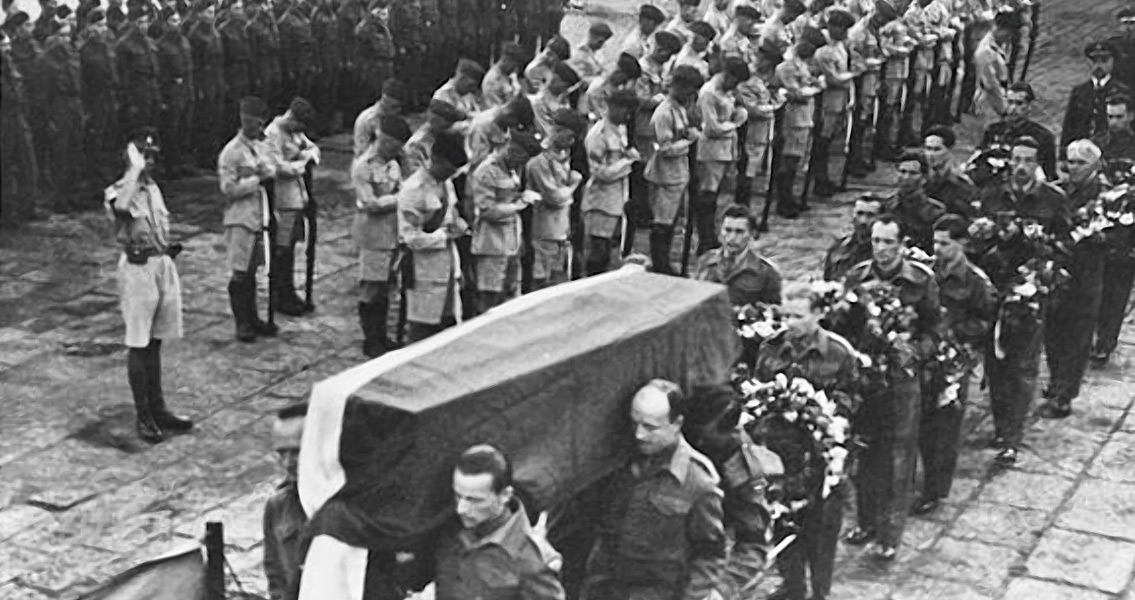<![CDATA[Within seconds of its take off on 4th July 1943, the B-24 Liberator aircraft carrying Wladyslaw Sikorski crashed into the sea off the coast of Gibraltar. General Sikorski, the head of the Polish government in exile, was killed alongside fifteen other passengers on the plane. Only the aircraft's pilot survived the crash. Witnesses claimed that before the aircraft had retracted its landing gear, it started to lose altitude dramatically. Coming at a time when Poland was at the centre of the war between the Soviet Union and Nazi Germany, and relations between the Soviet Union and the Polish government in exile were extremely poor, Sikorski's death was hugely controversial. Despite a British investigation soon after the crash concluding that it had been an accident caused by the aircraft's controls jamming, there were and continue to be accusations that Sikorski was assassinated. Sikorski was born in 1881, in a section of Poland which was then controlled by the Austro-Hungarian Empire. He served in the military, initially in the Austrian army, and then in the Polish legion of the Austrian army following the outbreak of the First World War. After over a century of foreign occupation, Poland became independent as a consequence of the Paris Peace Treaties which shaped Europe in the aftermath of the First World War. In 1919 the country was forced to defend itself from the advancing armies of the Soviet Union, with Sikorski serving as a general in the Polish military. Following Poland's success in the war, Sikorski, by then a national hero, served briefly as prime minister, from 1921-22. Following Nazi Germany's invasion of Poland in 1939, Sikorski became leader of the Polish government in exile. Initially working well with the Allied leaders, problems arose in 1943 when Sikorski requested the Red Cross launch an investigation into the Katyn massacre. The massacre took place in 1940, during the USSR's occupation of east Poland as part of the Molotov-Ribbentrop Pact. During the Soviet occupation, thousands of officers in the Polish military were rounded up and imprisoned. Following Germany's invasion of the Soviet occupied section of Poland in 1941, Poland requested that the Soviet Union, officially an ally of the government in exile, return the imprisoned officers. Mass graves, containing 4,000 Polish military personnel, were found by the German forces in the Katyn forest in 1943. Each of the men had been shot in the head with their hands tied behind their backs: suggesting they had all been massacred. Inevitably, the Soviet Union accused Germany of having massacred the Polish officers, and Germany made the same accusation towards the Soviet Union. In the midst of the battle against the Nazi war machine, it would have been a more convenient truth for the Allies if the massacre had been carried out by Nazi soldiers. On 15th April, 1943, the British government announced via the BBC that it had accepted the Soviet Union's version of events. It took until 1992 for the truth to be revealed, when the Russian government released documents stating that USSR'S secret police, the NKVD, had carried out the atrocity. Nevertheless, it was in the height of this controversy over Katyn that Sikorski's plane crashed. Sceptics have argued that he was assassinated, either by British or Soviet forces, as a means to prevent a full investigation into the massacre, something which could have disrupted the precarious alliance between Britain and the Soviet Union. Suggestions have ranged from Sikorski and the other passengers having been murdered before they boarded the flight, to charges of sabotage on the plane itself. Tests carried out on Sikorski's body in 2009, by the Polish Institute of National Remembrance, concluded that he had been killed in the plane crash. Nevertheless, there are still those that argue that the plane was sabotaged. The fact that the plane took off from a British base on Gibraltar has led many to accuse British authorities of either being directly involved in the sabotage, or at least taking on the role of a willing bystander and allowing the assassination to take place. Both Britain and Russia continue to refuse access to sections of their archives which could hold information on the affair. Although not necessarily proof of wrong doing - the documents likely remain classified to protect the identities of wartime spies - it undoubtedly adds to the continuing paranoia that a conspiracy of some sort took place on the 4th July, 1943. Image courtesy of Wikimedia Commons user: ]]>
Władysław Sikorski Killed in Plane Crash
